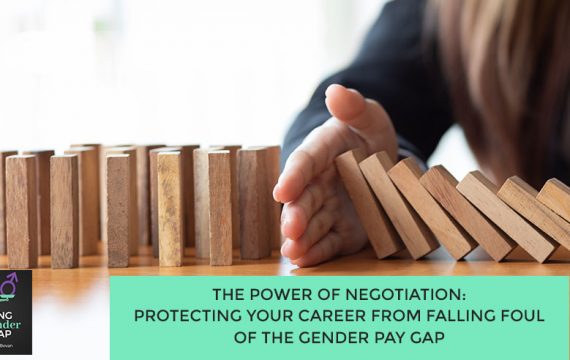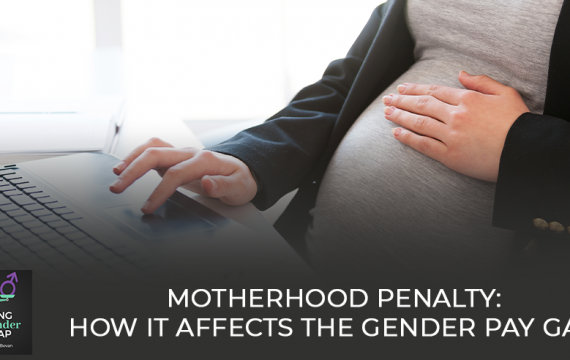As a woman, you should know your worth. Join Sherry Bevan in this episode as she discusses how women can protect their careers in this complicated world. Closing the gender pay gap requires a two-pronged approach. At the organizational level, we can implement initiatives to tackle female talent development and retention. At the individual level, there are actions that individual women can take to protect their careers from the gender pay gap. But, of course, all of these will still depend on the person’s willingness and courage to show their value.
—
Listen to the podcast here:
The Power Of Negotiation: Protecting Your Career From Falling Foul Of The Gender Pay Gap
Welcome back to the show. Thank you so much for joining me. I’d love you to come back next episode and to make that even easier, you simply need to subscribe to the show. Let’s get into the show. In this episode, I’m doing something a little bit different and we’re going to explore what individuals can do to protect their own careers from the gender pay gap.
When we think about the gender pay gap, one of the questions I often get asked is, “Who’s responsible for closing it. Who’s responsible for dealing with it? Who’s responsible for making that gender pay gap go away?” I’ve always believed that we have to take a two-pronged approach. We need to tackle it at the organizational level because there is unconscious bias and things don’t work the way we want them to work but we also need to tackle this at an individual level. That’s what I’d like to explore in this show.
In the very first episode of this show, we looked at equal pay and why equal pay is not the only solution for closing the gender pay gap. Equal pay is the law. You have to pay people the same amount of money for doing the work that is of the same value but we still have a gender pay gap even though equal pay came into law many years ago now. Since 2017, companies with more than 250 employees in the UK have been required to report on their gender pay gap. That is calculated as the difference between the average hourly earnings of men and women as a proportion of men’s average hourly earnings.
If we look at the most recent gender pay gap data, we can see that overall, in the UK, the gender pay gap is 18%. In other words, women earn 82% of what men earn. However, what we also see from the data is that the pay gap is highest for employees aged over 40, which is quite interesting. It does vary from sector to sector. In information and communication, it’s 18%. If you look at professional science and technology, it’s 16.2%.
You have to pay people the same amount of money for doing the work that is of the same value.
When I’m working with companies, when I first approach them, often, they tell me, “We’ve got an equal pay policy. We’re okay.” I hear from individual women, “We’ve got equal pay law. Why is there still a gender pay gap?” Some people don’t believe that there’s a gender pay gap. “We’ve got equal pay. There can’t still be a gender pay gap.” One thing we know for sure is that the evidence tells us otherwise. We’ve got equal pay but there is still a gender pay gap. It’s complicated. There are so many different factors.
We know that there are fewer women working in senior roles, which are getting paid more. That’s going to affect your gender pay gap. We know that women are less likely to negotiate on their starting salary and that affects your gender pay gap. Women are less likely to get promoted. Women are more likely to work part-time. There are more men than women in the higher-paying sectors such as technology and financial services. We know that women tend to prefer to work from home more often than men do.
What we also see is that while homeworkers may be 13% more productive, they get promoted less often. That’s something that I explore in more detail in my white paper that got published on The Impact Of The Hybrid Revolution On The Gender Pay Gap In Technology. Do pop over to my website and grab your copy of that white paper for more information about that.
For example, if we look at women in sales and technology, although women hit or exceed the quotas that have been set, they are often paid less in salary and commissions over time. Putting aside your role as an HR professional or a diversity and inclusion leader for one moment, putting aside the whole range of initiatives that hopefully you’ve got going at your organization to tackle this issue at the organizational level.
What I’d like to do in this episode is talk about what women as individuals can do from the other side, at the individual level. It is this two-pronged approach, tackling it at the organizational level and on the individual level. When I work with women on a one-to-one basis, I talk about introducing or implementing the triple-A plan. Tackling that pay gap and initial starting salary is important because whatever starting salary you get, that is going to affect over time your salary, pay rise, bonus and eventually your pension contribution.

It’s a knock-on effect because very often, your pay rise, bonus and pension contributions are done as a percentage of your salary. If one starts at $50,000 and one starts at $60,000 and to make the sums easy, let’s assume a 10% pay increase the following year, the women would be on $55,000 and the man would be on $66,000. If they then get another 10% increase the following year, that will add $5,500 to the woman’s salary and $6,600 onto the man’s salary. You can already see how that gap between the two is starting to widen.
Let’s look at the triple-A plan to protect your career from the gender pay gap. This is what individual women can do to protect their careers from that gender pay gap. The triple-A plan is about always asking for more, articulating your ambition and then auditing the work you do and the value of that work to the business. Let’s start with asking for more. In fact, I encourage my one-to-one clients to always ask for more.
Do women negotiate less often? Yes, they do. There have been numerous studies on this. The one that I’m referencing was published by Robert Half in 2018. They surveyed more than 2,700 workers employed in the US in professional environments. This survey was conducted by an independent research firm. What they looked at was the percentage of workers who tried to negotiate higher pay in their last job offer. They looked at this by gender and age. When we look at the overall figures, 39% of people try to negotiate higher pay, while 61% didn’t.
Overall, not even everybody tries to negotiate a better job offer. When we look at the figures by gender, what we see is that 46% of men, nearly half will negotiate or did negotiate a higher pay in the last job offer. Whereas for women, only 34% tried to negotiate higher pay. Interestingly, the data that they published also looks at age and it seems that the older you get, the less likely you are to negotiate on salary, which surprises me. When they’re looking at the 18 to 34 age bracket, 45%, they try to negotiate higher pay, 35 to 54 dropped down to 40% and then for 55 plus, it dropped down to 30%.
It’s all very well me telling you to always ask for more. How do you do that? There are a few different pieces involved. Before I start to talk about how I tackle this with my one-to-one clients, what I want you to do, first of all, is to check out the book called Ask For It by Linda Babcock. She sets out all useful strategies, how to structure that conversation and get what you want. The first thing to do when you’re asking for more is to take care of the mindset piece.
Make the most of the opportunities you’re offered, and don’t feel that you’ve got to say yes to everything.
Often, we don’t ask for more because we look at salary negotiation. We look at this as something personal and whatever you get offered is about your personal worth but it’s not. What you’ve got to remember is this is a business negotiation. It’s not a personal negotiation. Take care of that mindset piece first and get yourself into the frame of mind that this is a business negotiation.
Do your research and preparation. Find out what the salary ranges on that job are. If it’s not published and you are going through a recruitment agency, ask them. If it’s not published and you are going through it directly, who do you know works at the organization? Also, look at what the market research is telling you. What are these types of roles being advertised in the marketplace? When you’re talking about salaries and doing that negotiation, stay calm. Don’t allow this to become an emotional discussion. Try not to take it personally and talk about salary ranges.
The other thing that often my clients say to me is, “What if it’s not negotiable? Should I ask first?” Don’t ask if it’s negotiable. Assume that it is. Assume that it’s okay to ask for more. If it’s not negotiable, they’re going to tell you anyway. Why ask? Even if they say the salary is not negotiable, I would still ask. Don’t forget. Your job offer negotiation isn’t just about salary. It can also be about the hours you work and the benefits you get. It’s not about the actual money on the paid price.
When you’re talking about salary or job offer negotiation, it’s not just about the salary that you get. It’s also about looking at the benefits, flexible working, increased holiday and pension contributions. It’s not just about the money. If they present you with a job offer, you can go back and say, “That’s less than I was expecting for someone with my experience.” You can be very specific and tell them what you’re expecting. You can also give them that salary range.
The key thing here is to be ambitious and ask for more than you want but certainly, more than you expect. What we also know from the data is there’s a direct correlation between how much you asked for and how much you get. You’re going to be kicking yourself in the foot if you ask for an extra $10,000 and they say yes straight away because, “Could I have asked for an extra $15,000 or an extra $20,000?” Always be ambitious and ask for more than you want or expect. That’s part one of the triple-A plan is to ask for more always.

Part two of the triple-A plan is to articulate your ambitions. What we often see is that the people who get promoted are the ones you’ve talked about and articulated their skills and their ambitions. It’s important to talk about what you want. Talk to your manager about your ambitions, where you want to see your career going and the growth opportunities you want. Don’t assume that your manager will hear about everything that’s available and will always be looking out for you. You’ve got to do some of this work yourself.
If you hear about an opportunity in another team, an opportunity to go on secondment or an opportunity to get involved in a project that’s not directly related to what you’re doing, ask about it. Articulate your desire and what you want to get involved with. That’s important because it keeps you in front of mind. The other thing when it comes to articulating your ambition is, very often when we look at the way the girls at school and then as women when we get to university, the way that we tend to behave and communicate is different from that of boys and men when they get to school and then university.
Women often are brilliant at working hard. We graft, work hard and get great results. While you’re at school, college or university, that’s brilliant because you work hard, you study hard, you do your revision and you get brilliant grades at the end of it. That works when you’re at school or in the education system. In the workplace, that is completely different. People might notice that you’re working hard or see that you’re getting good results but the thing is, everyone is so busy working hard themselves.
People need to be reminded and be told that you’re getting these results and that you’re working hard. Working hard on its own is not enough. You need to be getting the results. You need to articulate your ambition and make sure that people know that you are ambitious and you want to move on and make progress. The final piece in the triple-A plan is about auditing the work that you do. What’s important is that when you’re working hard and getting those good results, audit the work that you do and how valuable is that work that you do to the business.
Audit everything that you do and grade it from 1 to 10, where one is the business couldn’t care less about that piece of work, to 10, where it’s absolutely critical and has a direct impact on the profitability of the organization. Review the work that you do. If you’re doing work that’s less than 7 out of 10, what can you do to make sure that you’re getting the opportunity to do work, to work with clients or projects that are graded 8, 9 or 10? When you’re doing work that is valued by the business, you are more likely to get seen. You’re more likely to get noticed and therefore, get promoted.
Always be ambitious and ask for more than what you want or expect.
Don’t get caught up in being busy and doing stuff that doesn’t affect the bottom line. Although, I have to say sometimes that can be smart and strategic. When I worked at Arthur Andersen many years ago, I volunteered to get involved with organizing the dinner dance for the firm, which took up an awful lot of time and energy but it was great fun and fantastic. It was a small group of us.
Sometimes, it can be smart or strategic to volunteer and get involved in things like that. I did this because I wanted to have fun and I love organizing events and doing that thing but also strategically, the managing partner was on the organization committee that year for the dinner dance. I wanted to get the opportunity to talk about my career and articulate my ambitions in front of him.
Doing stuff that doesn’t affect the bottom line isn’t always the most valuable use of your time but sometimes it can be smart or strategic to do that. Make the most of the opportunities you’re offered and don’t feel that you’ve got to say yes to everything. Be strategic, audit the opportunities before you say yes and do the ones that you can see will be of value to you in your career or have direct value to the business.
That is my triple-A plan for women who want to protect their careers from that gender pay gap. The triple-A plan is to always ask for more, articulate your ambitions and then finally audit the work that you do and its value to the business so that you can be sure that you’re doing work that is valued by the company.
Thank you so much for joining me. I hope you’ve got something valuable from this episode, exploring what individuals can do to protect their own career from falling foul of the gender pay gap.
If reading this has sparked an idea for you and your organization, please do book your exploratory chat with me. This will give you the opportunity to ask any questions you have about the work that I do with technology and cybersecurity companies on attracting, developing and retaining your female talent so that more of them get promoted, which means that you close the gender pay gap. You can get in touch with me by email at Sherry@SherryBevan.co.uk to book your call. Thanks for reading. Speak to you soon.






